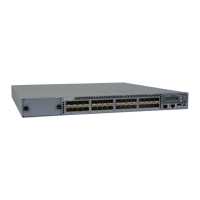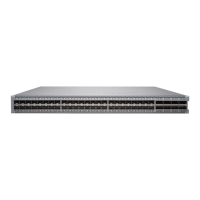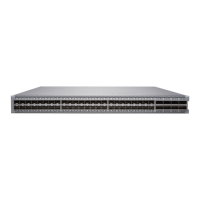• General Safety Guidelines and Warnings on page 267
• General Electrical Safety Guidelines and Warnings on page 299
• Prevention of Electrostatic Discharge Damage on page 301
Calculating the EX Series Switch Fiber-Optic Cable Power Budget
Calculate the link's power budget when planning fiber-optic cable layout and distances
to ensure that fiber-optic connections have sufficient power for correct operation. The
power budget is the maximum amount of power the link can transmit. When you calculate
the power budget, you use a worst-case analysis to provide a margin of error, even though
all the parts of an actual system do not operate at the worst-case levels.
To calculate the worst-case estimate for fiber-optic cable power budget (P
B
) for the
link:
1. Determine values for the link's minimum transmitter power (P
T
) and minimum receiver
sensitivity (P
R
). For example, here, (P
T
) and (P
R
) are measured in decibels, and
decibels are referred to one milliwatt (dBm).
P
T
= –15 dBm
P
R
= –28 dBm
NOTE: See the specifications for your transmitter and receiver to find the
minimum transmitter power and minimum receiver sensitivity.
2. Calculate the power budget (P
B
) by subtracting (P
R
) from (P
T
):
–15 dBm – (–28 dBm) = 13 dBm
Related
Documentation
Calculating the EX Series Switch Fiber-Optic Cable Power Margin on page 78•
• Understanding EX Series Switches Fiber-Optic Cable Signal Loss, Attenuation, and
Dispersion on page 123
• Pluggable Transceivers Supported on EX Series Switches
Calculating the EX Series Switch Fiber-Optic Cable Power Margin
Calculate the link's power margin when planning fiber-optic cable layout and distances
to ensure that fiber-optic connections have sufficient signal power to overcome system
losses and still satisfy the minimum input requirements of the receiver for the required
performance level. The power margin (P
M
) is the amount of power available after
attenuation or link loss (LL) has been subtracted from the power budget (P
B
).
When you calculate the power margin, you use a worst-case analysis to provide a margin
of error, even though all the parts of an actual system do not operate at worst-case
levels. A power margin (P
M
) greater than zero indicates that the power budget is sufficient
Copyright © 2015, Juniper Networks, Inc.78
EX4200 Switch Hardware Guide

